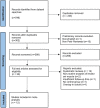Is levator ani avulsion a risk factor for prolapse recurrence? A systematic review and meta-analysis
- PMID: 35538253
- PMCID: PMC9270296
- DOI: 10.1007/s00192-022-05217-2
Is levator ani avulsion a risk factor for prolapse recurrence? A systematic review and meta-analysis
Abstract
Introduction and hypothesis: Levator ani muscle avulsion as a risk factor for prolapse recurrence is not well established. This systematic review was aimed at evaluating the correlation between levator ani avulsion and postoperative prolapse recurrence with meta-analysis, specifically, the risk of subjective or objective prolapse recurrence and reoperation.
Methods: The protocol was registered in the International Prospective Register of Systematic Reviews (registration number CRD42021256675). A systematic literature search was conducted using PubMed, EMBASE and Cochrane Database of Systematic Reviews to identify all peer-reviewed studies that described levator avulsion in women and investigated operative and postoperative outcomes. All peer-reviewed, English-language cohort studies in those with and without levator avulsion with a minimum of 3 months' follow-up were included. Pooled unadjusted and adjusted odds ratios were calculated for subjective recurrence, objective recurrence and rates of re-operation. The Cochrane Collaboration Risk of Bias In Non-Randomized Studies (RoBINS) and The Grading of Recommendations Assessment, Development and Evaluation (GRADE) tools were used to assess the quality of the studies included.
Results: Twelve studies with a total of 2,637 subjects and a follow-up period 0.3-6.4 years were identified. There were insufficient data to report a pooled adjusted risk for subjective recurrence and reoperation. On low to moderate quality-adjusted data, the pooled odds of objective recurrence was not significantly associated with levator ani avulsion (aOR 1.68; 95% CI 0.78-3.66).
Conclusion: Levator ani avulsion has not been confirmed as a risk factor for objective prolapse recurrence. Further evidence is needed to investigate the correlation between levator ani avulsion and the risk of subjective recurrence and reoperation.
Keywords: Levator ani muscle avulsion; Pelvic organ prolapse; Recurrence; Risk factors; Surgery.
© 2022. Crown.
Conflict of interest statement
None.
Figures







Similar articles
-
Diagnostic Accuracy and Clinical Implications of Translabial Ultrasound for the Assessment of Levator Ani Defects and Levator Ani Biometry in Women With Pelvic Organ Prolapse: A Systematic Review.Female Pelvic Med Reconstr Surg. 2017 Nov/Dec;23(6):420-428. doi: 10.1097/SPV.0000000000000402. Female Pelvic Med Reconstr Surg. 2017. PMID: 28134704
-
Surgery for women with posterior compartment prolapse.Cochrane Database Syst Rev. 2018 Mar 5;3(3):CD012975. doi: 10.1002/14651858.CD012975. Cochrane Database Syst Rev. 2018. PMID: 29502352 Free PMC article.
-
Is two-dimensional oblique parasagittal ultrasound imaging valid for levator ani muscle assessment?Ultrasound Obstet Gynecol. 2025 Jul;66(1):96-100. doi: 10.1002/uog.29236. Epub 2025 May 13. Ultrasound Obstet Gynecol. 2025. PMID: 40356535 Free PMC article.
-
Surgery for women with pelvic organ prolapse with or without stress urinary incontinence.Cochrane Database Syst Rev. 2018 Aug 19;8(8):CD013108. doi: 10.1002/14651858.CD013108. Cochrane Database Syst Rev. 2018. PMID: 30121956 Free PMC article.
-
Hiatus and pelvic floor failure patterns in pelvic organ prolapse: a 3D MRI study of structural interactions using a level III conceptual model.Am J Obstet Gynecol. 2025 Jul;233(1):47.e1-47.e12. doi: 10.1016/j.ajog.2025.01.011. Epub 2025 Jan 10. Am J Obstet Gynecol. 2025. PMID: 39800182
Cited by
-
Impact of levator ani muscle avulsions on Manchester procedure outcomes: A 5-year follow-up study.Acta Obstet Gynecol Scand. 2025 Jun;104(6):1200-1206. doi: 10.1111/aogs.15102. Epub 2025 Mar 30. Acta Obstet Gynecol Scand. 2025. PMID: 40159816 Free PMC article.
-
Effect of Vitamin D analog supplementation on levator ani strength and plasma Vitamin D receptor expression in uterine prolapse patients.Sci Rep. 2023 Mar 3;13(1):3616. doi: 10.1038/s41598-023-30842-2. Sci Rep. 2023. PMID: 36869168 Free PMC article.
-
Detection of Age-Related Pelvic Floor Fragility in Female Patients Using Magnetic Resonance Imaging.Int Urogynecol J. 2025 Jun 28. doi: 10.1007/s00192-025-06200-3. Online ahead of print. Int Urogynecol J. 2025. PMID: 40580220
-
Functional Anatomy of Urogenital Hiatus Closure: the Perineal Complex Triad Hypothesis.Int Urogynecol J. 2024 Feb;35(2):441-449. doi: 10.1007/s00192-023-05708-w. Epub 2024 Jan 11. Int Urogynecol J. 2024. PMID: 38206338 Free PMC article.
References
Publication types
MeSH terms
LinkOut - more resources
Full Text Sources
Medical

